Chaos is well known for its technology, specifically its rendering technologies. Recently, it unveiled Project Arena, a virtual production toolset that leverages the Chaos Vantage renderer to bring real-time ray tracing to virtual production. Project Arena is not ready for prime time just yet, as Chaos Innovation Lab continues to fine-tune it, as Chaos works with early adopters using it on real-world productions—one of which was created in-house. Using Project Arena, Chaos created the short film “Ray Tracing FTW.” Chaos took the high-production-value project seriously, from the costumes and makeup to the stunning imagery and set pieces for this Western-style production. The director, DP, and others involved in the short have serious film credits to their name. Conversely, the short, a spoof on the visual effects industry, is loaded with Easter eggs, with appearances by many VFX luminaries. The short is available now for viewing. Project Arena, meanwhile, will be available in 2025.
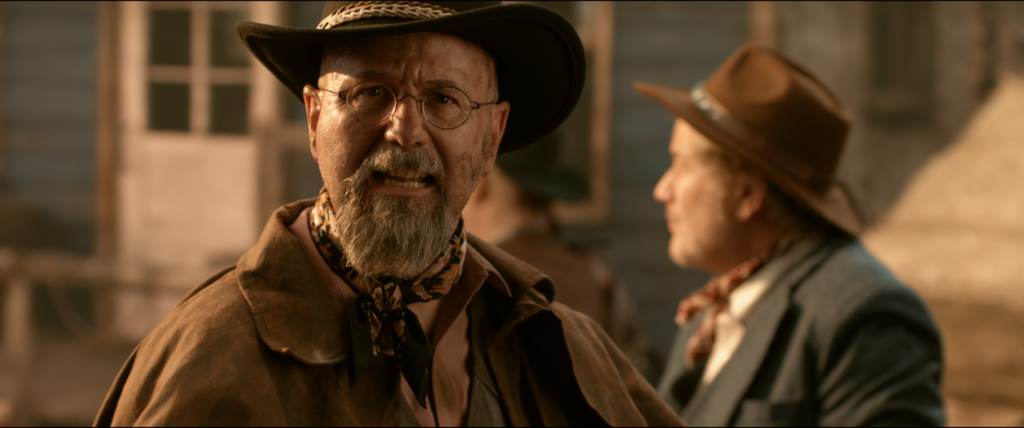
What do we think? Wow. The only way to truly do this high-quality work justice is to watch the film; it is really amazing. Kudos to Chaos and Chris Nichols (and friends) for taking on this challenge and having fun with it. Indeed, they have shown us their creative as well as technical sides.
As for the title of the film, “Ray Tracing FTW,” you might be wondering what FTW stands for. The film is a sequel to Chaos’ “V-Ray IRL,” for which IRL stands for “in real life,” which showed how Chaos’ rendering related to the real world. The new film, on the other hand, uses Chaos’ Vantage, Project Arena, and V-Ray, and focuses on the use of ray-tracing technology in real-time scenarios—thus the title “Ray Tracing FTW,” with the acronym meaning “for the win.” (It is not an anagram of a totally different but popular acronym.)
Chaos film-tests its latest tech
“I have vision, and the rest of the world wears bifocals.” — Butch Cassidy
Chaos is no stranger to the world of visual effects, with its flagship V-Ray renderer playing a significant role behind the camera, used by major studios on many film and television productions—including such blockbusters as Spider-Man: No Way Home, Moonfall, The Batman, Free Guy, and many others. In fact, it has even received an Academy Sci-Tech Award for its significant contribution to the advancement of motion-picture production.
Now, Chaos is also showing what it can do in front of the camera—in more ways than one.
Like Butch Cassidy, Chaos also has a vision. It has been working on something called Project Arena, a virtual production toolset that leverages the Chaos Vantage renderer to bring real-time ray tracing to virtual production, eliminating the need for a game engine. Developing and updating Chaos’ products and tech, of course, is the day job of executives at the company. However, for a very unique project, some of them tried their hand at acting, starring in a 10-minute short film called “Ray Tracing FTW” (watch it here). In fact, everyone in the movie is either from Chaos or associated in some way with visual effects—close industry friends of Chaos’ leadership who have contributed greatly to the industry over the years. For example, Sebastian Sylwan, CTO of Scanline, and Marcos Fajardo, creator of the Arnold renderer, appear as “VFX gamblers” in the film.
On a serious note, the short provides the first major test for Project Arena, so a full production shoot was implemented. On a lighter note, it offers a humorous look at the state of VFX and filmmaking from the artists’ points of view. And taken as a whole, the short is a love letter to one of Old Hollywood’s most popular genres—albeit crafted with modern tools (and opinions).
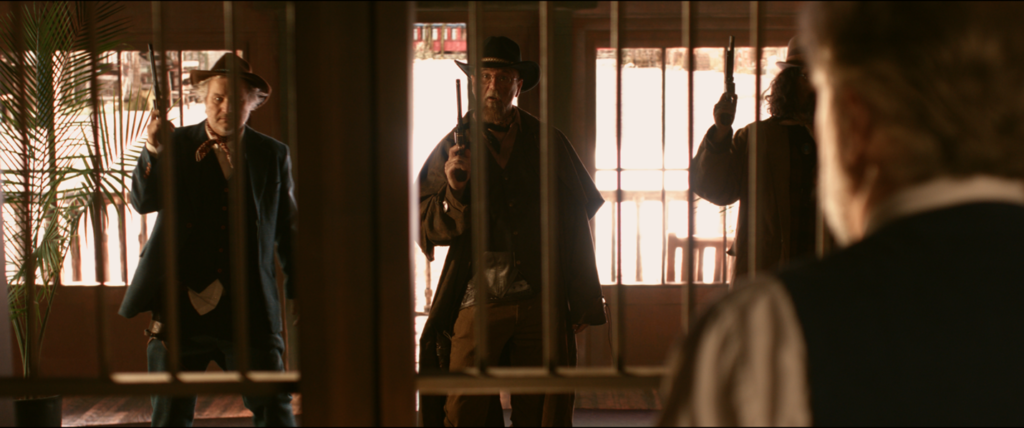
A press release or a podcast/video briefing discussing Project Arena would have been the typical approach to introducing the new toolset and explaining its merits, particularly the advantages it offers over the use of game engines in virtual production. And, the company did that. But hey, this is a creative team as much as a technical one. So, why not go that extra mile and, as they say, kill two birds with one stone—or in keeping with the theme of the short, shoot two vultures with one bullet?
“The best way to write the software is to put it in production. Being able to see the software used on the stage, that’s a whole different experience,” says Vladimir Koylazov, Chaos co-founder, who was cast in the role of the train conductor. He is also head of innovation at the company and co-invented V-Ray.
The team also wanted to highlight filmmaking as opposed to the technology, and this production accomplished that. “Our technology had to fit into our filmmaking efforts, not the other way around,” says Christopher Nichols, director of special projects at the Chaos Innovation Lab and actor, VFX supervisor, and producer of “Ray Tracing FTW.”
“Ray Tracing FTW” has an Old West theme, inspired by classics like Butch Cassidy and the Sundance Kid and Once Upon a Time in the West. Why the Western theme? Well, virtual production is revolutionizing classic filmmaking, turning the process on its head. “And when you look at classic filmmaking that was really big in Hollywood, a Western just made sense,” Nichols says.
“We wanted to look to the past and think of the future, and in terms of old-school Hollywood, Westerns just made sense. On top of that, it allowed us to play off the bank heist again, so our minds immediately went to Butch Cassidy and old spaghetti Westerns,” he adds.
For Chaos and the crew, this was not their first rodeo, as the short is a sequel to their first production— “V-Ray IRL,” a Heat-inspired short Chaos created more than a decade ago to celebrate V-Ray’s 10th anniversary. “In the previous short, we were making a love letter to V-Ray, and making a statement about how great VFX technology was at the time. In this one, we wanted to make a much broader statement about the VFX industry and filmmaking in Hollywood,” explains Nichols.
The film is filled with industry Easter eggs—cameos, references, and inside jokes—which folks familiar with VFX will certainly appreciate. The Easter eggs highlight the current challenges productions have in telling great stories and how real-time tools can work to their advantage. They are then incorporated into the Old West setting—for instance, a chrome ball, a stand-in wearing green unitard with tracking balls (played by Robert Nederhorst, VFX supe for John Wick 3), a GPU placed as a bet on the card table, a bartender wearing a facial capture rig, and more. The idea was to bring completely out-of-place items and place them in the past, where they kind of deserve to be at this point, says Daniel Thron, director.
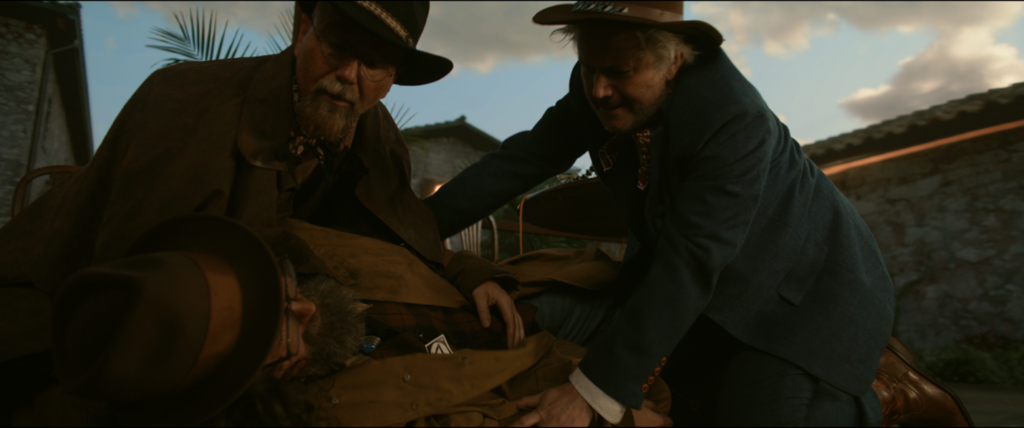
Nichols says: “Technology is too often a distraction on set. It crashes, doesn’t respond fast enough, or requires too many specialists to make it work right.” He notes that a lot of times, the only way to do computer graphics in real time was to use rasterized rendering. And while filmmakers can make things look real, it involves a lot of effort to do so. Conversely, Project Arena uses real-time ray tracing.
“We’ve been developing Project Arena to change all that, so everyone from the artist to the DP can stop thinking about the technology and just get back to the natural rhythms of filmmaking,” Nichols explains. “When you get real-time ray tracing, it’s the way light naturally works, so you don’t have to worry about it. So, ray tracing has to be part of the virtual production experience.”
While the company gets its point across with Hollywood-style action and comedy, visually speaking, the production was no joke, a true test with a high production value from participating veterans who have worked on Justified, Avengers: Infinity War, and Dune: Part Two. Serving as DP was Richard Crudo (Justified, American Pie), six-term form president of the American Society of Cinematographers.
As Nichols points out, no one involved in the project treated it as anything less than a major production—from the camera work, CGI, and VFX, to the costumes, makeup, to the theme song, sound design, and score. Why the extended effort? He notes that there are plenty of YouTube videos of people showcasing technology using home videos, “so we thought, why not see what it would look like if we shot it for real.”
Ready, Set, Action!
The vast majority of the short was shot predominantly on a 10,000-square-foot LED stage at Orbital Studios, using an Arri Alexa 35 camera with Panavision PVintage lenses, which replicate the original Ultra Speed lenses used in the 1970s—all of which helped to further give the film a Western-style look. Mark Griffith of FotoKem graded the film. The short was shot at 4.2K and finished at UHD in a 2.35 aspect ratio—“the way Westerns should be shot,” Nichols says.
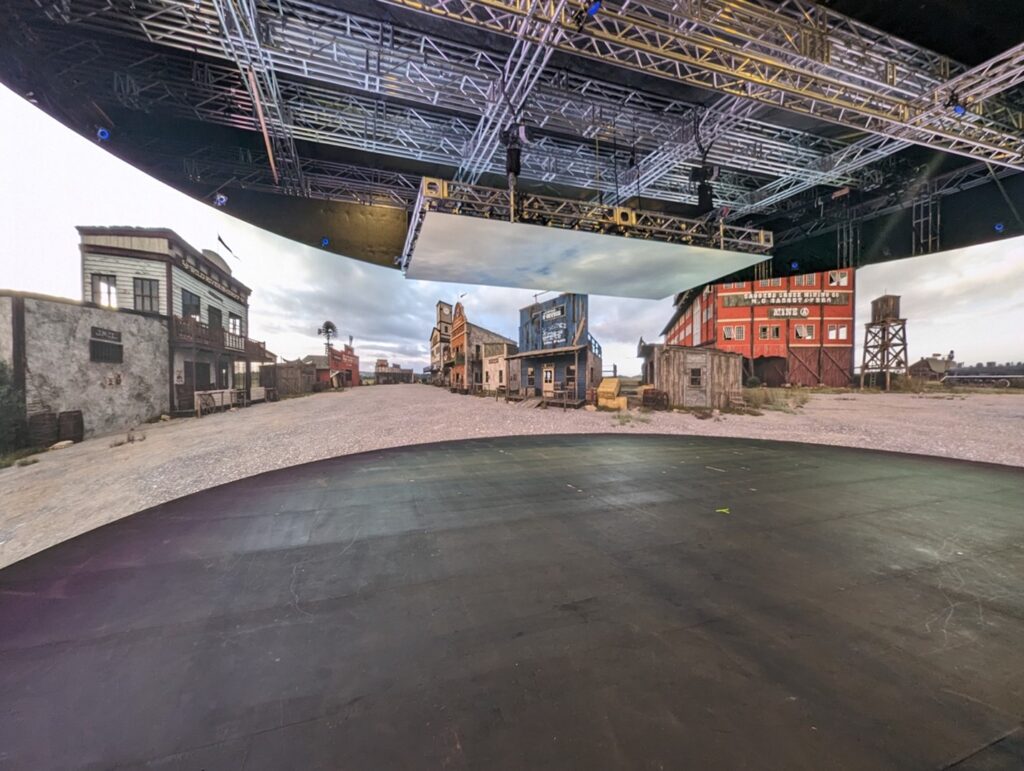
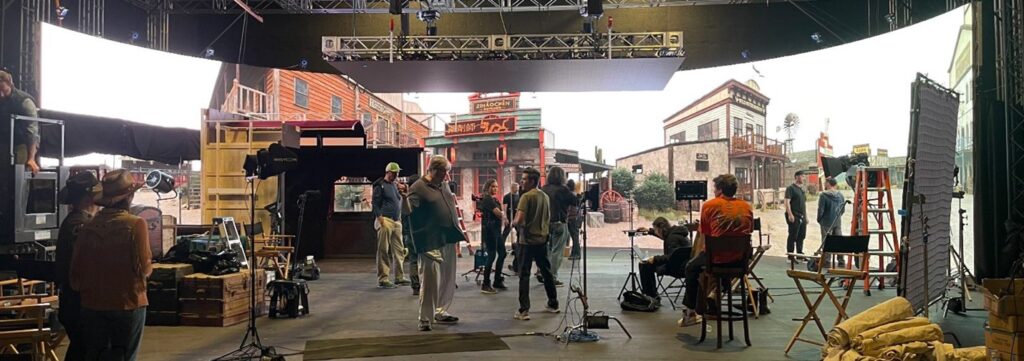
Feeding the LED stage screen was a massive V-Ray environment of an Old West town. The sets were designed by Erick Schiele (Sky Captain and the World of Tomorrow, Oblivion, I, Robot), who was also an actor and VFX artist on the short. Most of the sets were CGI, built by The Scope using a combination of SideFX’s Houdini and Autodesk’s Maya and 3ds Max, with V-Ray shaders. They were then converted to vrscenes, which were then loaded into Vantage and Project Arena. Some KitBash3D and TurboSquid assets were also used. Foundry’s Nuke was used by Marc Rienzo for compositing within the traditional VFX pipeline—from the muzzle flashes to the large all-CG shots.
In fact, the “sets” were actually one giant set comprising 2 trillion polygons “that we threw the kitchen sink at,” says Nichols.
Highly detailed CG models were used on everything from all-CG establishing shots and tunnel sequences to the background for a physical train car set, which was able to portray nuanced details by using full ray tracing, according to Chaos. And when a 3D hacienda was needed for the final shot in the short, the crew found just the location—and bought it online and got it on-screen in less than 15 minutes.
Schiele designed the world digitally, and then determined which parts to make physical. For example, the entire bank was built in CG, and then a physical wall was built between the robbers and the teller. A few midground elements were built, including a set of columns, to help sell the depth a bit more. For the town, a few props were also used as midground elements—the rest was digital.
The train, however, was the bigger build, according to Nichols. “We knew that a lot of interaction had to take place there. Erick designed the train car to be built in a modular manner, which allowed us to take it apart, reconfigure it easily, and convert it from a bar to a luggage car,” he says. “So for the train, just everything outside of it was CG.”
Because the CG blended seamlessly with the physical elements, Crudo says he was able to get almost every shot in-camera, with the exception of the train crashes that were from Bottleship. He also points out that the compositing process was quicker and more efficient with Project Arena, enabling him to take a more aggressive approach with creativity in the photography.
“By carefully managing the color and density values of the volume with the live foreground action, I was able to bake in the exact look I wanted. And since there was no guesswork to burden the special effects supervisor, the DI process was equally invigorating,” says Crudo.
In one scene, there is a virtual world through which the train with the robbers is traveling. The train rolls for about 2 minutes through the prairie, travels over a gorge, and a very tall bridge. The scene is long, about 4km (2.5 miles), and contains about 2.8 trillion triangles. It is ray-traced, and it’s live, Chaos emphasizes.
“Schiele designed a world featuring concept art that seemed very ambitious. But, I think it looks even better than I could have imagined,” Nichols says.
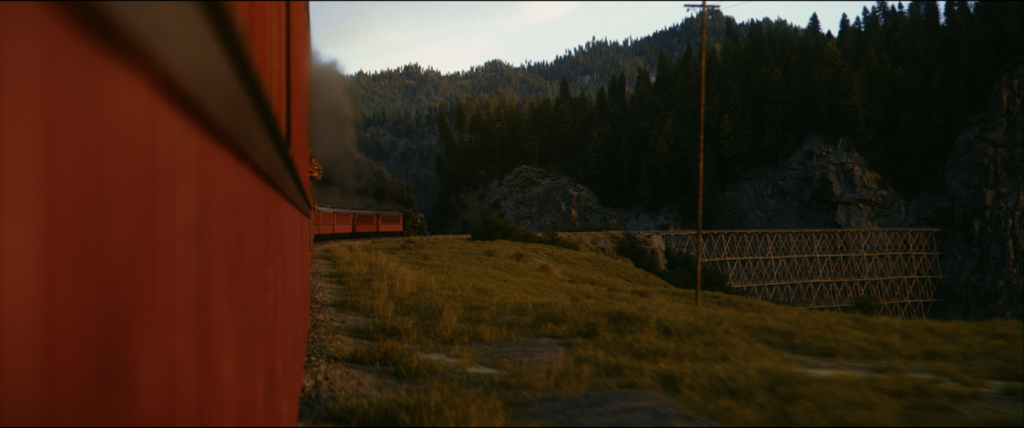
That’s a wrap!
There were a few goals, both technically and creatively, going into the project. The first was obvious, Does the technology work? So, how did Project Arena do on its screen test? “I am happy to report that it worked extremely well. For new software that had yet to be used in a production, it worked flawlessly and never crashed. It allowed us to do the entire shoot in three consecutive days, which is unheard of,” Nichols says.
In addition to the days spent filming, there was one day of prep/pre-light and one day of breakdown—all done without going into overtime, including the first day when they shot the whole train sequence, including the 30 setups. They also had a one-day shoot at a ranch in Piru, California, mainly to get the shots of the horses and the riders, but they also used that day to shoot some inserts. After filming, there were a few months of post work that involved editing, VFX shots, color, music, mix, and so on. The VFX went very smoothly, Nichols says, attributing that to them using the same assets they had built for virtual production.
For example, on our first day of pre-light, we had some networking issues on the virtual production stage because we were using a pipeline that is different from the perforce/Unreal pipeline. It took a bit to solve it, but once we did it ran really smoothly.
The second goal was perhaps more personal. Thron, Schiele, and Nichols have a podcast called Martini Giant, where they talk about their love of movies and filmmaking. This was an opportunity for them to make a statement about the state of filmmaking today, while showing that they know how to make a movie.
Chaos’ first film, “V-Ray IRL,” as well as “Ray Tracing FTW,” were directed and co-written by Thron (GI Joe: The Rise of Cobra, Oblivion, Blade Runner 2049, Real Steel), who also acted in and served as VFX artist on the recent production.
“Going from a small-scale robbery in the first version [“V-Ray IRL”] to large-scale Western cinematic craziness is the kind of jump we really wanted to make. We think that’s the kind of jump the technology lets you do,” says Thron. “By using a virtual production backdrop, we have so much more opportunity to make the experience richer, more elaborate, and more cinematic than before.”
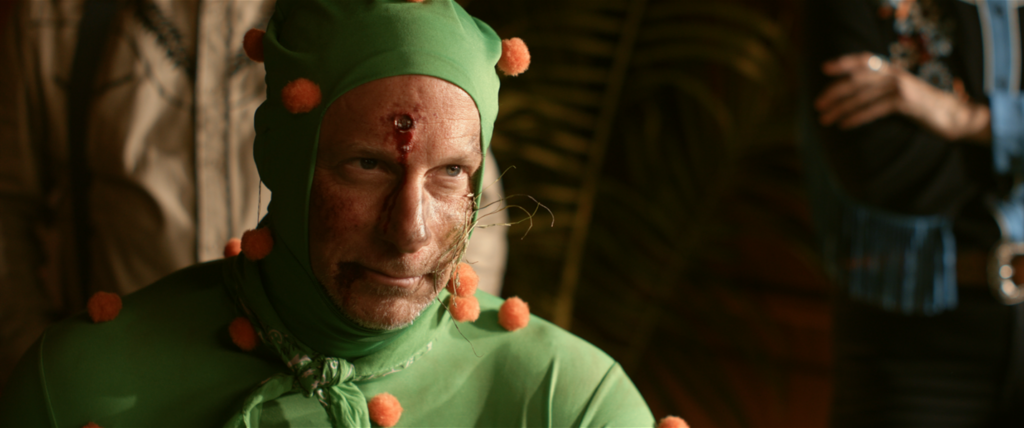
With this test behind them, Chaos continues to work on Project Arena, adding new features and so forth, but Nichols believes they are on the right path. He says Project Arena does not do everything that a game engine can do, and that’s fine with them—but it does make it much easier to get big environments added.
Nichols adds: “What makes Project Arena special is that it is not special. Today, most people think that in order to do virtual production or real-time rendering, you need to shift to a game engine. This is very disruptive to the normal workflow, not just for VFX, but filmmaking itself. Project Arena solves one simple problem: How to get 3D assets on the screen as simply and quickly as possible. You can do this without changing the way you want to work, using the pipeline you want—ShotGrid or even Perforce. You don’t need a special pipeline, you don’t need to hire special artists, you don’t need to build special assets.”
“Ray Tracing FTW”—indeed, it certainly lived up to its name.